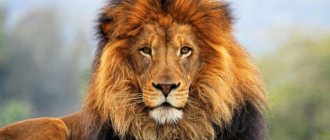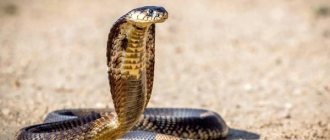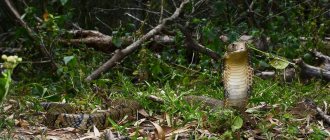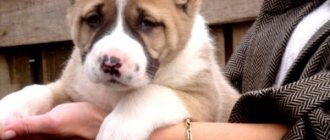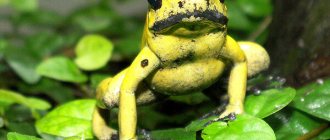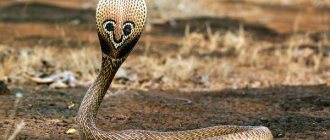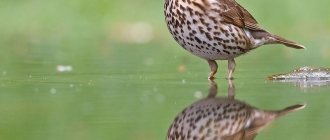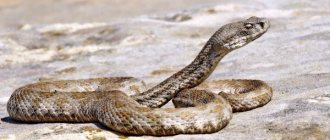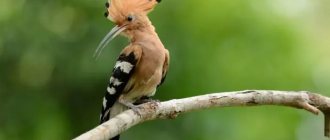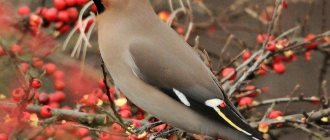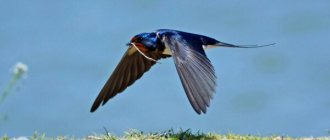Our country is home to many truly dangerous, poisonous animals that are best not encountered in their natural habitat. We invite you to get acquainted with the most dangerous representatives of the Russian fauna below.
Perhaps the most famous venomous snakes belonging to the adder family are the so-called true cobras. Probably, it is the representatives of this genus of snakes that are the most recognizable. At the same time, they are very widespread and include about twenty different species.
And one of the largest snakes of this genus living in the CIS is the Central Asian cobra .
Appearance of the Central Asian cobra
The total body length of the Central Asian cobra (including the tail) is over 2 meters, but as a rule, somewhat less - from 160 to 180 centimeters.
The maximum body length that was recorded was 161 centimeters. The length of the tail of the Central Asian cobra is approximately four to eight times less than the length of the body.
The upper body color ranges from dark brown to light olive. The belly has a light yellowish color. Juveniles have extremely bright transverse stripes of dark color in the form of rings closed on the belly.
Central Asian cobra (Naja oxiana).
As the snake matures, the main color tone becomes darker and the color of the rings becomes duller. At the same time, the rings become wider, and the stripes on the belly disappear. Instead of abdominal stripes, small or large spots are formed. The pupil of the Central Asian cobra's eye is round and its scales are smooth.
Which snakes are not poisonous
There are many more non-venomous reptiles than dangerous ones. Let's get to know them better so as not to cause harm:
The common snake is distributed throughout almost all of Europe and is found in some parts of Asia.
Also check out such non-venomous snakes as: tiger python, milk snake, reticulated python, corn snake, yellow-bellied snake and aesculapian snake.
In our middle latitudes the common copperhead is very common. Its length, as a rule, does not exceed seventy centimeters, and a fourth or fifth of the body is on the tail. The color of its back and belly is red-brown, copper. Hence the name of the reptile. Black spots are noticeable on the body; an arc of the same color runs from the nostrils to the beginning of the mouth. There is often a dark arc-shaped stripe on the head.
The snake also lives in our latitudes. It is less common and is represented by many species, and, accordingly, colors. Its distinctive feature is that it is very similar to a boa constrictor. And in length more than two, or even three meters.
Important! Non-venomous snakes should not be killed, especially snakes. With their smell and actions, they, in particular, repel vipers
If the snakes leave, vipers can easily take their place.
Defensive behavior of the Central Asian cobra
If the Central Asian cobra is disturbed, it takes a characteristic pose, raising the front part of its body upward to a height equal to approximately one-third of its length. At the same time, the cobra expands its neck and the part of its body adjacent to the neck, emitting a loud hiss.
If the animal or person who disturbed the cobra, despite the warning, comes close to the animal, then the cobra often does not make a “kill” attack, but instead tries to scare away the aggressor by inflicting a fake bite on him. For this purpose, the cobra sharply throws the front part of its body forward and hits the enemy with its head with its mouth closed, thereby protecting its poisonous teeth from possible breakage.
The Central Asian cobra reaches a large size - up to two meters.
It should be noted that a demonstrative defensive threatening pose is an innate behavioral element, and snakes that have just hatched from eggs take this pose in any danger.
Rattlesnake
Rattlers are found in North, Central and South America. All of them are poisonous, and the bite of some rattlesnakes can cause death. They got their interesting name due to the presence of a rattle - a thickening in the tail part. When danger approaches, the tail begins to vibrate and make a cracking noise. All nearby animals immediately guess what this crackling noise means.
The venom of this snake has hemotoxic properties: it causes coagulopathy (blood stops clotting) and also causes the death of organs and tissues. Its effect makes a person’s neck muscles hard as stone. The most toxic rattlesnake found in North America is the diamondback rattlesnake. One bite from this reptile would be enough to kill 15,000 mice. Its poison can cause not only hemorrhage, but also paralysis of the muscles of the respiratory system.
There is a chance to reduce the probability of death to 4%: the victim must be provided with timely medical assistance. But the scar from the bite will still remain.
Habitats and range of the Central Asian cobra
The Central Asian cobra is widespread in northwestern India, northeastern Iran, Pakistan, Afghanistan, Kyrgyzstan, Uzbekistan (to the north, up to the Bel-Tau-Ata mountains and the Nura-Tau ridge, and to the western spurs of the Turkestan ridge), southwestern Tajikistan and Turkmenistan (with the exception of the most extreme regions of the north-west of the country).
The Central Asian cobra lives mainly on slopes, among bushes and stones, in gorges, river valleys with coastal terraces, on the slopes of low mountains, gravelly and clayey foothills.
As the snake grows, the main color tone darkens, the rings become dull and wider, and large or small spots form on the belly.
The Central Asian cobra can often be found in gardens and along the edges of fields, on irrigated lands and along ditches. It is also often found among abandoned buildings. It can also be found on river banks. Central Asian cobras also enter waterless sandy deserts, where they try to stay close to gerbil colonies, which are located on the slopes of dunes and between them. In the mountains, the Central Asian cobra is found up to an altitude of two thousand meters above sea level.
Sandy efa
In Asian countries (on the Arabian Peninsula, India, Sri Lanka and South-West Asia) and Africa, ephas are found in sandy deserts and dry savannas. They become especially active after rain. These snakes have decent speed and a special way of moving along sand dunes. The sand epha has a somewhat unusual venom that acts very slowly: from the moment of the bite it can take 2-4 weeks before the person dies. The bite site begins to hurt first, then the bitten limb swells, blood pressure drops and tissue necrosis begins. But with timely administration of serum, a fatal outcome can be avoided. Sandy Effs have a rather aggressive and irritable character. Moreover, their habitat often comes into contact with the environment of human activity. Ephs are active at night. They attack with lightning speed, injecting hemotoxin, which destroys red blood cells, as well as muscle and organ tissue. In general, mortality from ephas bites is at a very high level.
Top articles : Temperate forests (temperate forests)
Lifestyle of the Central Asian cobra
The Central Asian cobra has a specific daily activity: in spring and autumn it is active during the daytime, in summer it is active in the mornings, evenings and nights. It must be said that in the autumn season this reptile appears on the surface of the earth much less often than in the spring.
If the cobra is disturbed, it raises the front part of its body up to 1/3 of its length, expanding its neck and adjacent part of the body, and emits a loud hiss.
In the warm season, the Central Asian cobra uses burrows of various rodents, reeds near water bodies, thickets of shrubs such as ephedra and blackberries, cracks in the soil, gullies and niches under stones as shelters. These cobras overwinter in more solid shelters. These are usually gerbil holes and deep cracks, sometimes located under residential buildings. The wintering of the Central Asian cobra continues for about six months. This period begins at the end of September - end of October and lasts at least until the end of March or until the end of April. Central Asian cobras molt twice a year – in autumn and spring.
These reptiles never form clusters, therefore they are not numerous anywhere.
Nutrition and diet of the Central Asian cobra
Almost half of the diet of Central Asian cobras (about forty percent) consists of various amphibians. Central Asian cobras are especially fond of green toads. Those cobra populations that live in river valleys readily eat lake frogs. In addition to amphibians, the Central Asian cobra also eats reptiles, including other snakes.
Before biting, the cobra first simply tries to scare off the enemy and inflicts a false bite, sharply protruding forward the front part of the body, protecting the poisonous teeth from breaking.
Among the snakes included in the diet of the Central Asian cobra, first of all it should be mentioned efu and boa constrictors, which can make up thirty to thirty-five percent of the diet of this cobra. Small mammals are also eaten. These are usually rodents, making up fifteen to twenty percent of the diet. On occasion, Central Asian cobras also feed on birds, which make up five to ten percent of the diet. Usually these are nightjars, small passerines and other small birds. Cobras do not disdain bird eggs. Juveniles often eat invertebrates.
Hunting of the Central Asian cobra
When the Central Asian cobra attacks prey, it, having grabbed onto its victim, does not lean back immediately, but strongly clenches its jaws several times and moves them over the victim’s body, which allows the cobra to better sink its poisonous teeth into the victim’s body and thereby inject the necessary dose poison.
Even newly hatched snakes adopt a defensive posture in case of any danger.
The most dangerous poisonous snakes
Snakes are known to use venom to forage for food and protect themselves. Before attacking the victim, they warn her. These predatory creatures swallow the caught trophy whole, without chewing, and in order for the prey not to interfere with this process, the snakes bite and release poison into them.
An interesting fact is that during self-defense, reptiles secrete more poison than during hunting.
Which snakes are the most poisonous and dangerous? First of all, these are the Rattlesnake, Mulga, King Cobra and Taipan.
When a person is bitten by any of these snakes, his rapid death is inevitable. Only an antidote will help. A small percentage of such cases have been identified in the world, but let’s still take a closer look at each type of these predatory creatures.
Reproduction of the Central Asian cobra
Cobras usually mate in May. The duration of pregnancy in representatives of this species of cobra is from sixty to sixty-five days. In July, the female cobra lays six to nineteen oblong-shaped eggs. The mass of each egg ranges from twelve to nineteen grams, and their length ranges from forty to fifty-four millimeters. Central Asian cobra cubs hatch at the earliest in the second half of August and until the end of September. The length of the hatchlings is from 31 to 39 millimeters. Central Asian cobras reach sexual maturity no earlier than in the third year of life, but no later than the fourth year.
Venom of the Central Asian cobra
The Central Asian cobra belongs to the extremely poisonous representatives of the aspid family. However, cases of Central Asian cobra attacks on domestic animals and people are extremely rare. The venom of Central Asian cobras has a pronounced neurotoxic effect. An animal, after an attack by a Central Asian cobra, initially shows signs of lethargy and passivity, but soon it begins to have convulsions, breathing becomes more frequent and more superficial, and after some time, death occurs as a result of paralysis of the respiratory center. At the same time, no local phenomena during the bite, such as hemorrhage or tumor, are observed.
The venom of the Central Asian cobra causes paralysis of the respiratory center and muscles, resulting in death.
The venom of Central Asian cobras is used in the manufacture of medicines, as well as in experimental biology. In order to obtain the venom of the Central Asian cobra, representatives of this species are kept in specially created nurseries for snakes - serpentariums.
Australian spinytail
The spiketail has a triangle-shaped head. It is not very long and graceful. This reminds me of a rattlesnake. But the properties of the toxic substance in its glands affect living organisms differently.
This representative of reptiles does not hesitate to feast on its relatives. Attacks snakes from a secret place. Death from an attack by the Australian spinytail occurs as a result of paralyzed respiratory arrest. Its venom is neurotoxic. Death can occur within six hours if antivenom is not administered. The antidote relieves the main symptoms and alleviates the condition of the victim. The chance of survival without the use of medication is no more than 50%.
Protection of the Central Asian cobra
Everywhere in the natural habitats of Central Asian cobras, their numbers are low. For this reason, Central Asian cobras are subject to protection. As for sandy deserts, the situation here is more favorable, but in more humid areas the number of this species is steadily declining due to the increasing destruction of habitat due to increasing anthropogenic pressure.
The most vulnerable populations are those of Central Asian cobras that live in river valleys, foothills and foothill deserts, where as a result of intensive human economic activity (mainly as a result of economic development), the habitats of cobras are destroyed.
Cobra venom is used to prepare medicines and in experimental biology.
The Central Asian cobra was listed as a rare species in the Red Books of the Soviet Union (in 1984), Turkmenistan (in 1985) and Uzbekistan (in 1983). Central Asian cobras were protected in the Syunt-Khasardag reserve, the Kopetdag, Repetek, Badkhyz and Gasan-Kuli sections of the Krasnovodsk reserve in Turkmenistan. It was also protected in the Karakul and Aral-Paigambarsky nature reserves of Uzbekistan and in the Tigrovaya Balka nature reserve located on the territory of Tajikistan.
After the collapse of the Soviet Union, representatives of this declining species were included in the Red Book of Uzbekistan, which happened in 2003, and in Turkmenistan, the Central Asian cobra was listed in the Red Book four years earlier.
Between 1986 and 1994, Central Asian cobras were listed as an endangered species in the International Red Book. After 1994 and to the present day, the Central Asian cobra is designated as a species of uncertain status on the Red List of the International Union for Conservation of Nature (IUCN). This status is due to the fact that the IUCN, starting from the mid-nineties of the twentieth century, does not have modern data on the population size of the Central Asian cobra.
In nature, the number of Central Asian cobras is low, so they are subject to protection.
Representatives of this species are listed in the second appendix of the Convention on International Trade in Endangered Species of Wild Flora and Fauna (CITES).
Breeding Central Asian cobras
In the early eighties of the twentieth century, three hundred to three hundred fifty Central Asian cobras were kept annually in serpentariums and zoos. Successful incubations of clutches of cobra eggs have also been carried out, which were obtained from females that were fertilized in nature.
In India it is called “wound”, in Afghanistan and Pakistan - “Pashto”, in Uzbekistan - “boiling snake”. But, regardless of the name, the sand epha (lat. Echis carinatus) causes fear wherever it appears. Its bite is fatal for every fifth person, and those who managed to survive cannot be called “lucky”: the venom of epha leads to kidney problems that bother the victim for the rest of his life.
This poisonous snake is found in Central Asia and North Africa. The Central Asian efa (lat. Echis carinatus multisquamatus) lives on the territory of Uzbekistan, Turkmenistan and Tajikistan - a subspecies of the sand epha, which is sometimes considered as a separate species. Prefers lumpy sands with saxaul thickets, river cliffs and abandoned dwellings.
But he doesn’t like to get close to human habitation. It attacks only when the person himself disturbs it. Protecting himself and his offspring, he acts with lightning speed, putting all his strength and rage into the throw. By the way, she can jump to a height of up to half her body, so it is not recommended to approach her closer than 2-3 meters.
The sand faff warns the enemy of its attack not by hissing, but by a loud rustling sound, which it makes when the jagged side scales rub. The sound itself resembles the crackling of hot oil in a frying pan, for which it was nicknamed the “boiling” or “noisy” snake.
The method of movement of the sand faff is also interesting. She moves sideways, first throwing her head to the side, then moving the back of her body sideways and slightly forward, and finally pulling up the rest of her body. This makes it much easier for her to find support on unstable sandy soil. After such movement, separate oblique strips with hooked ends remain on the sand.
The sand faff moves quite quickly. In general, this is a nimble and active reptile that does not like to lie on a stone for a long time, like its other relatives. It is because of this that its diet includes mobile and small desert inhabitants: small rodents, frogs, lizards, toads and small snakes of other species. Young people are content with scolopedras, scorpions, locusts and very small lizards.
The sand epha hunts both during the day and at night. In the heat it hides, crawling out of its hiding places only at sunset. During the rest of the year, it prefers to look for prey during daylight hours. It may not hibernate if the winters are warm enough. In this case, mating begins in January, and young snakes are born in March. If winters are cold, then the breeding season shifts by a couple of months.
It is curious that this snake does not lay eggs, but immediately gives birth to from 3 to 16 snakes, 10-16 cm long. The sand epha shows itself to be a caring mother, so it will bite anyone who dares to approach its brood.
Young snakes grow quickly, reaching a length of 50-60 cm (maximum 75 cm) by adulthood. Moreover, males are slightly larger than females. The body of adult snakes of both sexes is golden-sandy in color with large white spots along the entire length. A zigzag pattern is clearly visible on the side of the body. The bottom is light yellow, and the head is decorated with a kind of cross. Probably to remind you: stay away from me!
Phalanx spider
Phalanx spider is translated from Latin as “running away from the sun.” In different countries, this land animal is called differently - camel, bihork, salpuga, wind scorpion. This species is most common in hot and warm countries of the Northern and Southern Hemispheres. The phalanx spider is a fairly large arthropod, its length can reach 70 millimeters. The animal has a sandy-yellow, brown, whitish color. Its body is divided into three sections - abdomen, chest and head. This is a distinctive feature of spiders of this species. The head is convex and very large. The chest is divided into three segments. The abdomen consists of nine to ten segments. Three pairs of limbs are attached to the head section. They correspond to two pairs of jaws and mandibles. The remaining segments are attached to the three thoracic segments. The first pair of limbs, facing forward, is located at the anterior edge of the head. In terms of its functions, it corresponds to the mandibles and is called chelicerae.
These oral appendages are quite large, with powerful claws and swollen main segments. The shape of the forelimbs resembles thick large claws. Their role is to capture and grind food. The second and third pair of segments (pedipalpi) resemble tentacles that act like legs when walking. The hind limbs are much longer than the rest. Below, on their coxae, there are five pairs of peculiar organs (appendages). Their functions could not be reliably determined. These are believed to be sensory organs. The pedipalps, legs and chelicerae are covered with a powerful head shield. The ocular tubercle with two convex pupils is located on the anterior edge of the head shield. Representatives of this species of spider can be found in arid regions (Mongolia, Gobi Desert, Greece, North Caucasus, Spain, Central Asia, Crimea, Lower Volga region).
These animals are predators by nature, so they go hunting mainly at night. They feed on a variety of insects and small arthropods: beetles, termites, woodlice, and lizards. When attacking their prey, spiders emit a sharp squeak to intimidate the enemy. Some individuals are so maneuverable that they can overcome a scorpion. The arthropod is capable of speeds of more than 16 km/h. During the day, the phalanx spider hides in a shelter - these can be burrows of rodents and other animals. Moreover, the arthropod changes its location every night. However, seeing the phalanx is not that difficult. It is necessary to light a large fire, and the snot will come running into the bright light. The phalanx spider is voracious and indiscriminate in its eating, especially for fertilized females. Mating games take place at night. During the mating period, the female is so inert that the male has to drag her along with him. Fertilization is carried out by the spermatophore method. The male phalanx releases a sticky liquid containing sperm, then, with the help of chelicerae, picks it up and directs it into the genital opening of the spider. After copulation, the female becomes very active. After a certain time after consuming food, she lays eggs in a shallow hole. An adult is capable of reproducing from 40 to 200 larvae. After two to three weeks, young spiders are born. At first they are inactive, devoid of hairs and joints and covered with a transparent thin shell. After three weeks, molting begins, the integument dismembers and hardens. With the appearance of hairs, the phalanx spider can move. The female stays next to the cubs and brings them food until the babies get stronger. The spider does not have venom glands. However, its bite can cause serious consequences for humans. Large individuals can easily bite through human skin. Since rotting food remains on the chelicerae, with a bite they can get into the wound and cause inflammation. Therefore, when attacked by a phalanx, it is necessary to treat the damaged area with an antiseptic solution. In 1992, the animal was included in the Red Book.
South Russian tarantula: beautiful and harmless
The South Russian tarantula, or mizgir , is a poisonous large spider belonging to the family of wolf spiders. It is distributed in southern Russia and Central Asia. It lives in steppe, forest-steppe and desert zones, preferring moist soils with high groundwater levels. The length of its body covered with hairs can reach 35 mm. Hairs perform a tactile function. Its color depends on the habitat and can be light red, brown-red, black-brown and almost black. The body of the spider consists of a small cephalothorax connected by a thin constriction to a fairly large abdomen.
On the cephalothorax there are several ocelli, a pair of claws (used to hold and kill prey) and a pair of claws (serving as an organ of touch). In addition, there is also an almost black “hat”, which distinguishes the South Russian tarantula from other members of the family. The photo shows it well. This spider has 4 pairs of walking legs. There are spider warts on its abdomen. The liquid released from these warts instantly hardens in air and turns into a spider's thread. It also has poisonous glands. The poison enters the victim’s body through ducts in the claws of the mandibles. These spiders are dioecious, with males smaller than females. The South Russian tarantula does not weave trapping nets; it uses the web to cover the walls of its home, build an egg cocoon, and to overcome obstacles. It is thanks to the web that the tarantula is able to get out of the glass jar. He hunts mainly at night and not far from the mink. If during the day a random insect enters the spider’s home, then it does not refuse an unexpected lunch. The South Russian tarantula spider reacts to a shadow that appears near a burrow. He believes that it is some kind of insect, and therefore jumps out in the hope of catching it. If you tie an object to a thread and create a semblance of movement near the hole, then in this way the South Russian tarantula can be lured out of its home.
Spiders mate in August. After this procedure, males do not survive the winter and die. Copulated females and young animals remain for the winter, climbing into deep burrows they have dug and sealing the entrance with earth. At the beginning of next summer, the female lays eggs, entwining them with a web. She carries the resulting cocoon on herself, supporting it with her hind limbs. The spiderlings emerging from the eggs hold on to their mother’s abdomen for some time. The female heads to the water to drink and feed the young. Having drunk, the spider moves across open areas and drops spiderlings in different places, dispersing them in this way. Young individuals first look for shelter, and later begin to dig minks. The South Russian tarantula rarely bites people, only for the purpose of self-defense.
It happens that a spider that gets into a tent (dwelling) crawls over a sleeping person. A person, feeling tickled, sluggishly tries to remove the source that disturbs sleep. The spider may consider this movement a threat and bite a sleeping person. Therefore, when in nature, before going to bed, you need to shake out all your things and tightly close the entrance to the tent. The bite of a mizgir is quite painful, but not fatal. Causes swelling and redness. The bite site must be burned with a match as quickly as possible, since high temperature promotes the disintegration of the injected poison. This method is applicable for bites of all poisonous spiders.
If you are planning a trip to Crimea, then you should definitely know about one biting creature that lives in those parts. We are talking about centipede... funny name, isn't it? But the Crimean scolopendra itself is not at all a funny and not friendly little animal.
Who are centipedes? These are labiopods belonging to the order Scolopendra. The family and genus that this animal belongs to are also called scolopendra.
What does the Crimean centipede look like?
Crimean ringed scolopendra
On the Crimean peninsula there is one species - ringed centipedes. These creatures are dark brown in color, they look like a huge worm on an infinite number of legs...
The size of the Crimean centipede is not too large - only 10 to 12 centimeters. These are really not the largest representatives of the scolopendra genus, there are even longer ones!
Ephas, or sandy ephas (lat. Echis carinatus)
In addition to being one of the Big Four, sand ephs are ranked third in the Top 10 Most Dangerous Snakes due to their irritable, aggressive nature and deadly venom. And also their habitat is in close proximity to people. They are nocturnal and can be seen in the late evening in arid areas and dry savannas north of the equator, including Africa, Arabia, Southwest Asia and India, as well as Sri Lanka. They strike very quickly, releasing hemotoxin, a poison that destroys red blood cells and causes damage to tissues and organs. Mortality rates from these bites are extremely high. Although the antidote is quite effective along with medical treatment, sand ephs are believed to be responsible for a large number of human deaths.
Lifestyle of the Crimean centipede
This animal prefers to spend most of its time in damp and dark places - lying under stones, ruins of trees, in crevices. During the daytime it is passive, hiding from prying eyes, but at sunset it goes out hunting.
The legs of the centipede are perfectly adapted for hunting. When she sees the prey, she catches up with it and grabs it with her tenacious front legs. After that, he plunges his jaws, containing a toxic substance, into her body.
The Crimean centipede is a very fast runner. Before you kill her, try to catch up first! But even having overtaken a centipede, crushing it is not so easy. The body is very flat, so even hitting with a stone will not help on soft ground.
In addition to all other “advantages”, the Crimean centipede is an excellent sprinter.
Scolopendra is an inhabitant of warm climate zones; this animal cannot tolerate temperatures below zero degrees.
Reproduction
Mating between a male and a female occurs over several hours, often in the dark. With the back pair of legs, the male weaves a cocoon containing seminal fluid. The female scolopendra draws the spermatophore into her body, thus fertilization occurs. After several weeks, and sometimes months, the female lays a clutch consisting of 20 - 130 eggs. All the time the offspring are maturing in the eggs, the female is next to them, holding them between her many legs.
Small centipedes are born after 2 - 3 months. At first, the young remain with their mother in the nest. But this, in fact, is not such a rosy sight... Sometimes a female centipede is eaten by her own offspring! That's it kids! Well, sometimes the new mother herself is not averse to eating little centipedes. They have strange family relationships, don't they? Definitely don’t expect any good from such animals!
If you see a centipede nearby in Crimea, just let it go... past.
The age to which centipedes live in nature has not been established. But in captivity, these creatures live for 7 years.
Blister beetle
The scarlet blister beetle is also dangerous to humanity. It is called that only because it leaves blisters and abscesses on the human body after bites, which are difficult to deal with. The insect has a very ordinary appearance, one feature is its elongated body. But if the affected areas of the body are injured, they can begin to develop serious diseases of the kidneys, liver and bladder. This phenomenon is especially observed in children, because their skin is delicate and they constantly scratch their bites.
If a large amount of poison enters the human body, it can be fatal to the person. If we go back several hundred years, in ancient times the poison of this insect was fed to kings when they wanted them to die in agony. More than one hundred and fifty species of this insect are known today . But these are only those that live in Russia. Very often they are found in the forests of the Krasnodar Territory, therefore, when going on vacation, you need to be extremely attentive and careful.
The red-bellied toad is a small frog: the length of its chalk reaches a maximum of 6 centimeters.
The upper part of the body has a nondescript color: the background is gray, and on it there are various dark or greenish stains and spots.
But the abdomen is very bright: red or orange-red in color with a marbled pattern of a bluish-black hue.
Red-bellied Firebird (Bombina bombina).
Males are smaller than females, but they have larger heads, and they also have resonators. During the breeding season, distinct nuptial calluses appear on the first two front toes and on the forearms of males.
The red-bellied toad secretes a poisonous foamy secretion from its glands. This secretion is much more poisonous than that of most amphibians. In addition, when in danger, the toaded toad behaves in a special way: it throws its legs over its back, making their bright colors visible, sometimes it rolls over on its back and shows off its multi-colored belly. The bright color warns the predator that its prey is poisonous.
Spitting mechanism
Spitting cobras, photos of which can be seen in our material, shoot venom through curved channels that are located in the teeth. Such holes can open at the first need. The toxic substance is produced from the channels due to the contraction of special muscles on the snake's neck. This is where the glands are located that replenish the supply of toxic substances.
After leaving the cobra's mouth, toxic substances can reach a target at a distance of up to three meters. As the results of special studies show, such snakes have the ability to accumulate venom, the volume of which is sufficient for several dozen “shots” at a time.
The described mechanism is observed in African spitting cobras. The Central Asian variety is also capable of shooting poison over a considerable distance. However, in this species, the toxic substance shoots out from a special hole under the tongue, in the area of the lower jaw.
The main purpose of the defense mechanism is to get toxic substances into the eyes of the enemy, be it an animal or a person. Having detected danger, the cobra raises its head and keeps the target in sight. Then a spit occurs, which is directed slightly above the enemy’s head. Having reached its destination, the poison leads to clouding of the cornea of the eye in a short time. The result is often complete blindness of the victim. Moreover, toxic substances irritate the skin, causing destruction of its structure.
Sometimes spitting cobras make mistakes. But this doesn't happen often. The reason is usually a good reaction from the potential target. In some cases, cobras mistake shiny elements on a person’s clothing for eyes.
Fire toad's lifestyle
The red-bellied firebird is common in Europe.
These frogs prefer a mostly aquatic lifestyle. But representatives of the species can also be found on land, although only in damp places. Red-bellied toads live on flat terrain - in steppes, mixed and deciduous forests. As a habitat, they choose reservoirs with a clay bottom, in which the water stands and warms up well - these are small lakes, ditches, swamps, ponds and rice paddies. Although they prefer a water temperature of +2 degrees, they can be active at temperatures from +10 to +30.
As a rule, red-bellied toads are not numerous, but in certain places they accumulate in large quantities. Despite the fact that these frogs are attached to water, they can move over a distance of about a hundred meters when searching for a new body of water. But they usually travel at night, when air humidity is high.
Further reading[edit]
- Wüster, Wolfgang (1993). "A Century of Confusion: Asian Cobras Revisited." Vivarium
.
4
(4): 14–18. - Eichwald E (1831). Zoologia specialis, quam expositis animalibus tum vivis, tum fossilibus potissimuni rossiae in Universum, et poloniae in specie, in usum lectionum publicarum in Universitate Caesarea Vilnensi
. Vilnius: Zavadsky. (in Latin). - Wüster, Wolfgang; Thorpe, Roger S. (1991). "Asian Cobras: Taxonomy and Snakebite". Experience
.
47
(2):205–209. DOI: 10.1007/BF01945429. PMID 2001726. S2CID 26579314. - Wüster W., Thorpe R.S. (1992). "Asian cobras: population taxonomy of the Naja naja
(Serpentes: Elapidae) species complex in India and Central Asia".
Herpetologica
.
48
(1):69–85. JSTOR 3892921. - Wüster W (1998). "Cobras of the genus Naja
in India".
Hamadryad
.
23
(1): 15–32.
Reproduction of red-bellied toads
The breeding season for representatives of the species begins in April-May, when the water temperature exceeds +14 degrees. Males “sing” during this period, regularly emitting a monotonous trill - “unk-unk-unk”. They can make up to 40 sounds per minute, and in warm water they make sounds more often than in cool water. Moreover, males can sing not only on the surface of the water, but also under water. Males sing most actively in the central part of the range at the end of April - mid-May, but the breeding season continues throughout the year.
These frogs are listed in the Red Book of the Moscow Region.
Females lay eggs in portions, each clutch contains from 2 to 80 eggs, but their total number reaches 300 pieces. They lay their eggs in shallow water, and there must be aquatic vegetation, since the eggs are attached to the leaves of plants.
Depending on the temperature, after 4-12 days tadpoles appear, the body length of which is about 5 millimeters. The tadpoles of fire-bellied toads are excellent swimmers, unlike other tailless amphibians. At the same time, they are real hunters, actively swimming, they catch small aquatic life: copepods, rotifers, protozoa, and in addition they feed on algae and other vegetation.
Larval development continues, after which the tadpole turns into a frog. The young remain in the water or in close proximity to it. They reach sexual maturity in the 2-4th year of life. In nature, the life expectancy of red-bellied firebirds is on average 12 years, and in captivity the record long-liver lived up to 29 years. Adult toads consume both terrestrial and aquatic invertebrates.
Fire-bellied toads live up to 29 years - this is a record among frogs.
